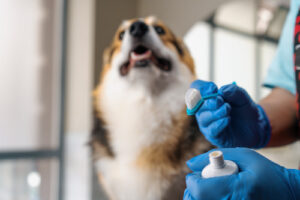It starts with something small—maybe your dog suddenly won’t get up from their bed, or your cat is hiding and won’t eat. At first, you wonder if it’s just a passing issue. But as the minutes tick by, that uneasy feeling grows. Is this something serious? Should you wait it out or head straight to the emergency vet? Many pet owners have faced this moment of doubt, and the uncertainty can feel overwhelming. Below, we’ll walk you through seven red flags that mean your pet needs urgent care, so you can act with confidence and protect their health. If your pet shows any of the signs below, call us immediately at (713) 526-5881 for 24/7 emergency vet care at Sunset Animal Hospital.
Difficulty Breathing
Any sign of labored, rapid, or shallow breathing should be taken seriously. Respiratory distress can quickly escalate and put your pet’s life in danger. You might notice your pet standing with elbows splayed, neck extended, or showing visible chest movement with each breath. Cats, in particular, tend to hide breathing issues until they become severe.
What Causes It?
Breathing problems may be linked to heart disease, allergic reactions, respiratory infections, trauma, or heatstroke. Regardless of the cause, a pet struggling to breathe needs to be seen by an emergency vet right away.
Continuous Vomiting or Diarrhea
Occasional digestive upset is not unusual, but repeated vomiting or diarrhea—especially if it lasts more than a few hours or contains blood—can point to something more serious.
Risks of Dehydration and Underlying Illness
Continuous vomiting or diarrhea can lead to dangerous dehydration and may indicate poisoning, a gastrointestinal blockage, or an underlying condition like pancreatitis. If your pet is unable to keep water down or starts acting lethargic, don’t wait. Contact our emergency vet team immediately.
Collapse or Inability to Stand
Sudden collapse or weakness that prevents your pet from standing or walking normally can indicate a medical emergency. You might see your pet stumble, drag their limbs, or be completely unresponsive.
Potential Medical Emergencies
This could be the result of internal bleeding, trauma, low blood sugar, toxin ingestion, or a cardiovascular issue. Immediate evaluation at an emergency vet clinic is necessary to identify the cause and stabilize your pet.
Seizures or Neurological Changes
Seizures can vary in severity and duration, but even a single episode warrants a call to the emergency vet. If your pet experiences multiple seizures close together (cluster seizures), or the seizure lasts more than a couple of minutes, this becomes even more urgent.
Additional Neurological Warning Signs
Keep an eye out for other neurological symptoms, such as disorientation, head tilting, walking in circles, or sudden behavioral changes. These signs may indicate a serious condition affecting the brain or nervous system that requires emergency care.
Uncontrolled Bleeding or Major Trauma
Visible wounds, bleeding that doesn’t stop, or signs of internal trauma—such as a swollen abdomen or pale gums—should be treated as urgent medical situations. Even if your pet seems stable after an accident, they could still be suffering from internal injuries.
When to Act Fast
Injuries from vehicle collisions, falls, animal bites, or blunt force trauma all require immediate evaluation. Internal bleeding may not be visible at first, but it can be fatal without quick intervention from an emergency vet.
Ingestion of a Toxic Substance
Pets are naturally curious, which sometimes leads them to chew or eat things they shouldn’t. Ingesting toxic substances such as medications, cleaning products, chocolate, grapes, or xylitol (found in sugar-free gum and treats) can lead to severe illness or death.
What to Do Next
If you know or suspect your pet has eaten something harmful, call our emergency vet team right away. Do not try to induce vomiting at home unless your veterinarian instructs you to do so. Quick action can greatly improve your pet’s outcome.
Swollen or Bloated Abdomen
A distended abdomen can signal serious and potentially fatal conditions such as gastric dilatation-volvulus (GDV), also known as bloat. This is especially common in large, deep-chested dogs, but it can occur in any breed.
Recognizing the Signs
Symptoms often include restlessness, unsuccessful attempts to vomit, drooling, or a visibly swollen stomach. GDV progresses quickly and requires immediate surgical intervention. If your pet shows any of these signs, head to the emergency vet without delay.
Why Quick Action Matters in Emergencies
In pet emergencies, every minute counts. Many of the conditions listed above can worsen rapidly if left untreated, reducing the chances of a full recovery. Even if you’re unsure whether your pet’s condition qualifies as an emergency, it’s always better to reach out and ask. Our emergency vet team at Sunset Animal Hospital is trained to assess these situations and provide guidance on what steps to take next.
We are available to handle emergencies 24/7 and are equipped with in-house diagnostics, advanced surgical tools, and an experienced veterinary team.If you notice any of the signs listed in this blog, don’t wait. Call (713) 526-5881 for around the clock emergency care today.





